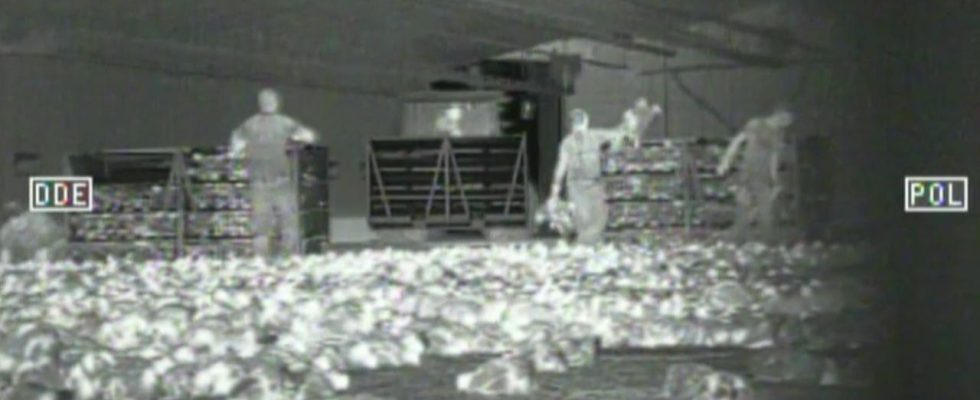exclusive
Employees step on the bodies of the broilers and break their chests or legs – animal rights activists documented this in a poultry farm in Lower Saxony. A veterinarian sees it as “pure sadism”.
The company is hidden from view on a country road in Emsland. The dimensions of the system cannot be seen from the outside. Only drone images give the impression of a large farm in which more than 100,000 broilers are fattened at the same time. According to the animal welfare organization SOKO Tierschutz, animals were tortured here.
It is based on images of animal welfare activists from the animal rights group SOKO Tierschutz, who have been filming for weeks how employees of capture crews brutally pack broilers and throw them into plastic crates before they are transported to the slaughterhouse. These recordings are the ARD-political desk Report Mainz exclusively before.
A broiler in the barn of a fattening farm in Lower Saxony.
On it you can see employees of the exhibition company pushing each other into the mass of chickens. They fall on the animals, others throw chickens as if they were throwing a ball. Friedrich Mülln, head of SOKO Animal Welfare assesses the images opposite Report Mainz as a “documentation of brutal animal cruelty”. The animals would be picked from the ground in bunches, as the activist puts it, carried around upside down by the legs and then rattled into boxes. The animals are almost at the end after the 45-day fattening anyway. If you just press on the body, you can already hurt the animals.
The recordings were Report Mainz leaked. The editors consulted a veterinarian as an expert and submitted the recordings to her for assessment. She sees in it a “pleasure in torment, in the suffering of others”. If there was no need, women would step on animals and break their chests, bones, wings and legs. This is pure sadism. These are crimes, not misdemeanors.
Company does not want to comment
Report Mainz tried to confront the managing director of the fattening farm with the recordings. But he declined an interview. He didn’t want to look at the image material, although the editors had offered it to him several times. A lawyer for the company reports:
“When loading animals, our client works with a specialist company that has been specially approved for this purpose, which has a good reputation in the market and in the past (…) there has never been any reason for complaints (…).”
Employees are fired
The “highly respected specialist company” is also based in Emsland. As Report Mainz shows the manager the recordings, he explains that he will fire the employees filmed here. That’s not how you would work in your company.
So is this just an isolated case? Many injured and damaged animals can be seen in other recordings – including dead animals. They look like they’ve been there a long time. We also show these pictures to the competent veterinary office.
Workers carry poultry to their transport boxes.
The official veterinarian explains the pictures: You see significant violations of applicable animal protection law, it is said. Seriously ill individual animals would be shown, which would have to be treated immediately or killed in an animal-friendly manner. Dead animals can also be seen in the barn, which were not removed immediately. The criminal relevance will be checked.
Basic problems with capture columns
Why is it that employees of capture teams act so ruthlessly? Can the work lead to disinhibition among the employees? The sociologist Marcel Sebastian has dealt with this question scientifically.
To do this, he has conducted interviews with people who work in animal farming and concludes that “those who work in such farms should be able to be largely unaffected when they see something like this, if they see animal suffering”. They hardened over time, the inhibition threshold fell from time to time. One could certainly speak of a kind of disinhibition.
In fact, it’s not the first time that Report Mainz reported about animal cruelty by capture crews. The topic has been taken up again and again by the editors since 2010 because the editors have repeatedly found out about violations.
policy confirmed research results basically
In addition, the way the capture crews worked was examined in a whole series of investigations and studies. There is always talk of injured animals arriving at the slaughterhouse.
The Lower Saxony Ministry of Agriculture reports reports from slaughterhouses that there are fundamental problems with fishing crews. The ministry keeps getting information from the slaughterhouses about catch damage, according to Minister Miriam Staudte, B’90/Die Grünen Report Mainz. Feedback was received that more and more animals were injured on the last truck of a transport. Apparently, people get tired and then become more violent, she says. In the current case, criminal charges have been filed.
Expert also calls for the exhibitions to be checked
Experts such as the veterinarian Kirsten Tönnies therefore call for a complete control of the stall processes in the poultry farms. Opposite Report Mainz She explains: The veterinarians would have to inspect the animal stock before it went to the slaughterhouse. So the stalling should also be controlled in order to avoid cruelty, as can be seen in the picture material.
The veterinary office in Meppen, confronted with this demand, writes Report Mainz: “The official slaughter poultry inspection is generally carried out before moving out. Responsibility for carrying out the moving out in accordance with animal welfare lies with the animal owner and the company commissioned with loading the animals. Official monitoring of the moving out process can only take place on a random basis.”
So if only random checks are carried out, it cannot be determined whether animal cruelty is occurring or not.

